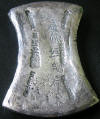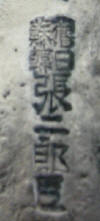A Canton Jin Ze Tax Treasury Silver from the Southern Sung Dynasty
一件南宋廣州經制庫銀
Weight: 456 grams/12.5 taels
Date: N/A
Inscriptions:
By stamping: 霸北街西/重壹拾貳兩半/霸北街西
霸北街西/舊日蘇韓張二郎□/霸北街西
West of Ba Bei Street (Address of the silver shop where was in the capital Ling An (Now, Hangzhou))
Weighed Twelve and a Half Taels
(Successor or assignee of) the former Su Firm and Its Smith Han Wu Lang- Silversmith Zhang Er Lang
By engraving: 廣州經制庫銀
Treasury Silver of Canton (Guangzhou) Collected from Jin Ze
經制錢 (Jin Ze Money) was a kind of financial income created in the 4th year of the 宣和 Hsuan Ho reign (1122 A.D.) in the Northern Sung Dynasty. The sources of the income, among many others, include tax increases, revenues of monopoly business such as wine and salt, profits from exchange of currencies.... It was abandoned just a few years later when was in the 靖康 Jin Kang reign (1126 A.D.) - the last reign of the Northern Sung, before it was terminated by the Jin tribe.
The financial policy of 經制錢 (Jin Ze Money) was soon resumed by the new ruler of the Southern Sung Dynasty in the 2nd year of the 建炎 Jien Yen reign (1128 A.D.) as an important financial aid to its war against the Jin tribe. It took effect throughout the dynasty. The imperial government of the Southern Sung further created another financial income named 總制錢 (Zhong Ze Money), the source of that income was mainly from adjusting then existing shares between the imperial government and the local governments on the local taxes. The two financial incomes- 經制錢 (Jin Ze Money) and 總制錢 (Zhong Ze Money), were usually called as 經總制錢 (Jin Zhong Ze Money) and gradually became a major income for each board of revenue and emperor.
This piece show that Canton (Guangzhou) had established an exclusive treasury for storing 經制錢 Jin Ze Money, and actually, 經制錢 Jin Ze Money was also made and stored in the form of silver sycee, in stead of cash money. According to the inscriptions, this piece was cast by a silversmith in the West of Ba Bei Street, Capital Lin An (Hangzhou), it is also an indication that the Canton Treasury formerly transported silver to Lin An and consign the silversmith to recast it in order to meet the acceptance criteria of the imperial treasury.
There's some noteworthy inscriptions on this piece, which are concerning the change of ownership of silvershop's business. The smith making this piece was named 張二郎 Zhang Er Lang, on top of his name chop, but it is unusual to find a stamp of 舊日蘇韓 (the former Su Han), and it is very difficult to realize what does this stamp mean. According to the webmaster's research, 蘇 韓 is assumed to be an abbreviation of 蘇鋪韓五郎 (Su Firm and its Silversmith Hang Wu Lang), and they had been assigned by various government sectors to cast tax silver. Obviously, the silvershop and its business were assigned to or succeeded by Zhang Er Lang, due to a cause unknown to us, but, in order to take over the fame of this reputable silver shop, the new runner indicated the predecessor of the silver shop with that stamp.
Post scripts in Nov.30, 2004: This piece is assumed to be part from the Nanjing excavation.
Return to Sycee Talks

